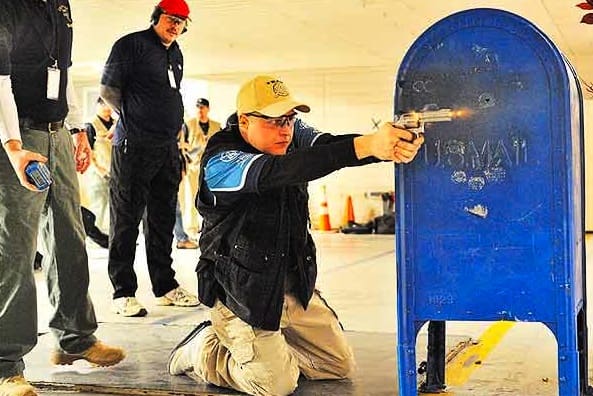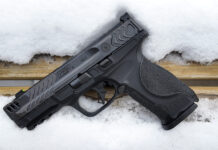The above photo was ripped from a press release on the 2011 IDPA Indoor National Championships. I include it here at the risk of stimulating another debate between the rabbi and Patrick Carrube about the advantages and disadvantages of IDPA competition for shooters trying to hone their real world self-defense shooting skills. Knowing that kneeling isn’t as good as crouching, at least in terms of shooting and moving. Suffice it to say, a mailbox is not cover. The bullet hole in the middle of the mailbox’s flank is a dead giveaway. Literally . . .
Seeking “cover” means sheltering behind something that can stop bullets. The mailbox above is—potentially but not ideally—“concealment.” Like many supposedly “solid” objects in our environment, it’s something that hides you and . . . that’s it. The moment you start shooting from behind concealment, it’s the ballistic equivalent of shouting “Yoo hoo! Over here!”
Unless you hit what you’re aiming at, the decision to open fire from behind concealment can be coffin full of not good. It may be better to move from concealment to the relative safety of cover. Knowing the difference between the two, and their respective limitations, can be the difference between life and death. So let’s review two key characteristics of cover and concealment . . .
1. Cover is extremely hard to find –
A car’s engine block is good cover; most rounds won’t penetrate all that heavy metal. Or is it? Where EXACTLY does the engine sit inside the engine bay of the car in question? In most cop shows, the good guys drape their bodies over a car and fire. Huh? Don’t forget your feet; the bad guy can shoot your feet.
How about walls? Alright then. You stand on one side of a wall of your choice. We’ll put a shooter on the other. Ready? I thought not. The walls inside your house are not cover. Appliances are better, but they may have nasty things like gas and hot water lines attached.
Trees are better. As long as they’re not dead, or hollow inside. And large enough to cover your whole body. At the appropriate angle. Which will change if your attacker knows you’re behind the tree. How will you monitor his or their movements without exposing your head to gunfire?
Earth. Now that’s good cover. If you can get down behind a dip in the ground, putting some earth between you and the bad guy, you’re safe. Or not. TTAG commentator BambiB reminds us that the NRA’s “Firearms Fact Book” states that a .30-cal AP round will penetrate 48-56 inches of earth, depending on how hard-packed it is.
In short, unless you know what constitutes good cover and where it is before bad things start to happen and stand ready to get there, the chances of finding it in the middle of a life-or-death situation are none to slim. Which leaves you with two options: fight or hide. Or hide and fight. Or fight and hide. That’s still two right?
2. Concealment is temporary
Concealment is relatively easy to find. Whether you’re in a Stop ‘N Rob or your own home, there are plenty of places to hide. If you’re in a life threatening situation, draw your gun as you move for concealment. Look for cover.
If you’re with friendlies, try to hide in different places. If shooting starts, you do NOT want them by your side. Don’t get rooted to the spot. Keep track of the bad guy’s movements so you can stay out of sight. As the perp or perps move, your concealment may disappear. Assume you will have to move at some point.
As soon as you engage the enemy, or the enemy discovers you, your cover is compromised. At that point, you can fight, run for cover, or re-conceal. Ideally, you should fight while running for cover or concealment.
Don’t discount the option of re-concealment—especially in the heat of battle. In the Detroit police station shootout, the cop kept popping-up and shooting from the same point behind the desk. Big mistake. The perp IDed his exact 10-40, charged and shot off the cop’s fingers.
Bottom line: gun fights are geographically dynamic, even within a small environment like a store or home. Have a plan for seeking cover or concealment. And then make another one. And another. Get a blue gun and practice (in private).
Oh, and fire from behind cover or concealment. Sticking your gun hand out next to cover or concealment is a good way to challenge yourself to fight the rest of the conflict with your weak hand. A skill you should also practice.





Bottom line: gun fights are geographically dynamic, even within a small environment like a store or home.
I know it’s over the top fiction but have any of you seen the shootout in the hospital at the end of Hard Boiled when Mad Dog and Tony are blasting away at each other less than 5′ apart?
Fight or hide? Sometimes there is a third option — run. That’s why my back-up-gun is a pair of track shoes. If I can, I’ll use my gun to lay down suppressing fire so I can get out of Dodge. For as we all know, he who runs away real fast won’t catch a bullet up his ass.
I recall reading, perhaps in a 1980s police training textbook, that USPS mail drop boxes are good protection against pistol bullets. They’re not good cover against rifle fire (few things are, other than entrenchments or large trees) but mail drop boxes do give at least two layers of heavy-gauge steel between you and trouble, and they’re wide enough for most of us to shelter behind.
If the shooters weren’t targeting me directly, I’d run like hell. But I’d rather fight from behind a steel drop box than take my chances running from someone actively firing at me.
Sounds like we have a test! Where can we get a hold of a surplus U.S. Mailbox?
Be carefull though. Shooting a U.S. Mailbox is a federal crime.
Bad cover (mail drop box) is better than no cover.
Unless your opponent has had proper training in armed conflict, s/he is going to succumb to the natural, physiological affects of a fight-flight moment. The human eye is drawn in such a situation toward movement and/or the exact point of danger (your muzzle as it returns fire — just off to the side of the box). Where the eye looks, it shoots.
This is why the average driver gets in an accident when things go wrong on the road (where the eye looks, it steers). For instance, in a skid, most drivers lock on to that big nasty tree, and not the road. Not surprisingly, the car ends up right smack upside the point of danger. Or the eye locks on the truck swerving into the lane ahead, and not the shoulder to the side which offers a path of avoidance…and they steer right into the point of danger instead.
With you behind the bad cover of the mailbox, the attacker is looking/shooting at the very small target of your hands, gun, and top of your head (see training clause above). Under the stress of a gun battle, that’s a mighty tall order. Unless your adversary has considerable skill at arms, this thought is rarely likely to occur…
“Mailbox, thin gauge steel, possibly full of letters, maybe some publication media…even my 9mm hollow point is likely to penetrate. Aim to the 5 o’clock of the shooter’s head, walk fire up to the 11.”*
So in short, get to bad cover if that’s what is available. Sure, a spray ‘n pray might hit you, and a combat experienced marine certainly will. But you stand a whole lot better chance behind that mailbox as you face a robber with a gun than you do running for a tree too far.
*Assuming you’re facing a right-handed opponent.
According to the NRA’s “Firearms Fact Book”, a .30-cal AP round will penetrate 48-56 inches of earth (depending on how hard-packed it is).
Maybe “a dip in the ground” is only concealment after all?
Whoa. Amending text. Thanks.
I’d rather be IN a dip in the ground than be the dip on the ground…
Comments are closed.